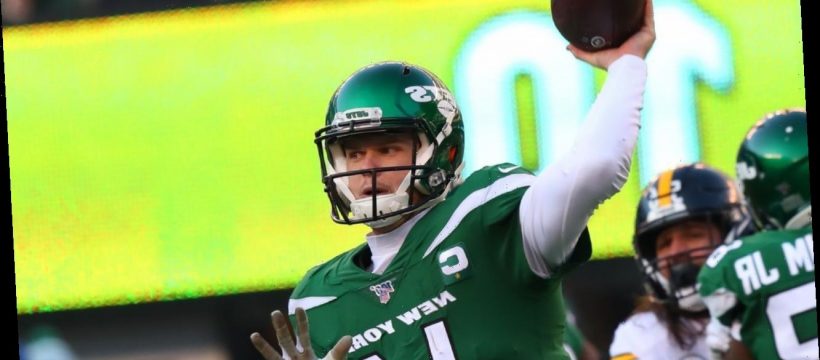- Senior Stats Analyst for ESPN Stats & Information
- Contributes to ESPN Chalk section
- Worked at ESPN since 2009
In a standard fantasy football league, waiting on a quarterback is commonplace. Just look at ESPN.com’s player projections: The lowest-rated starting-caliber quarterbacks in a 12-team league right now are Carson Wentz (10th), Drew Brees (11th) and either Josh Allen (12th) or Aaron Rodgers (13th), depending on preference.
Not winding up with Lamar Jackson or Patrick Mahomes is hardly catastrophic, especially when that same high pick can be invested at any of the other three major positions.
The relative stability of the QB position is one reason for the growing popularity of two-quarterback leagues, where waiting on a quarterback becomes a slightly more dangerous game. To begin with, there’s an awful lot more to sift through when you’re trying to wait for two spots; standard ESPN.com projections have 22 different quarterbacks averaging between 14.0 and 16.5 PPG next season, going from 18th to 39th in rank.
Removing the Robert Griffin III/Matt Schaub types (players who earn their projections in a spot-duty or mop-up role) leaves a still-significant pile of quarterbacks to pick from, many of whom you can wait on (even in a 2-QB league) and still expect to outperform their draft slot.
Here are a few quarterbacks worth targeting in deep quarterback leagues:
Sam Darnold, New York Jets
In 2019, Darnold (who turns only 23 next month) was the 24th-ranked quarterback in fantasy points per game among guys with 10-plus games played. That puts him right on the edge of startable in a 12-team, 2-QB league — and unless you live in Jets country or Southern California, you won’t have to reach for him. He’s projected as QB25 this season by ESPN.com.
Darnold was pressured on 36% of his pass plays last season, second-highest in the league behind Russell Wilson (37%), whose style of play basically invites it. This wasn’t a Sam-only issue — when Darnold was out, the Jets still allowed pressure on 37% of pass plays, worst in the league.
OK, so no team allowed more pressure, but even that general statement undersells the problem. Even when the ball got out in two seconds or less, Darnold saw pressure at more than three times the NFL average rate.
That issue is a big reason general manager Joe Douglas signed four different offensive linemen in free agency and drafted two offensive tackles, including Mekhi Becton at 11th overall. When Darnold wasn’t pressured last season, he completed 71% of his passes for 7.7 yards per attempt (14 TDs, 6 INTs).
You can’t expect the Jets’ offense to generate many big plays when the line is that bad. Consider that in the NFL as a whole last season, quarterbacks held the ball for an average of 3.2 seconds before throwing a 40-plus-yard touchdown. When Jets quarterbacks held the ball for 3.2 seconds, they were pressured on more than half of their pass plays (51%).
Weapons are obviously still an issue — Breshad Perriman and rookie Denzel Mims are the two main offseason wide receiver adds. But tight end Chris Herndon should basically be considered an offseason addition after playing a total of 16 snaps in 2019, a campaign he entered with high expectations. Better blocking and more Herndon (plus the return in a possible Jamal Adams trade) could make Darnold a more effective and higher-volume passer.
Philip Rivers, Indianapolis Colts
Did someone say offensive line upgrade? ESPN’s PBWR (pass block win rate) measures the percentage of pass blocks an offensive lineman can sustain for at least 2.5 seconds, approximately the NFL average time to release for a quarterback.
The five Colts starters from a year ago average a PBWR of 91.9%, a mark that only one starting Chargers lineman reached (center Scott Quessenberry). Rivers shouldn’t have a problem with interior pressure, considering guard Quenton Nelson and center Ryan Kelly both ranked in the top 25 of all offensive linemen in that measure.
No quarterback in the NFL threw more interceptions when pressured last season than Rivers (seven), who completed more than 71% of his passes for 8.2 yards per attempt when not pressured last season. Given how quickly Rivers gets the ball out (fifth-lowest average time to pass in 2019) compared to Jacoby Brissett (second-longest), pressure shouldn’t be a problem.
Rivers also has an intriguing group of pass-catchers to work with, including 2019 second-round pick Parris Campbell and 2020 second-round pick Michael Pittman Jr. Injuries defined Campbell’s 2019 season, but the upside is substantial — Campbell played for an Ohio State program that’s also produced Michael Thomas, Terry McLaurin and Curtis Samuel over the past five years. In his final college season (2018), Campbell caught an FBS-best 82% of his targets out of the slot, where Frank Reich has said Campbell will play more next season.
Pittman ran a 4.52 40-yard dash at 6-foot-4, 223 pounds at his pre-draft combine, showing impressive athletic skills to go with his 101-catch 2019 season at USC. Mixing in T.Y. Hilton gives Rivers a high-ceiling wide receiver group to go with Jack Doyle and Trey Burton at tight end.
Assuming Rivers is an upgrade over Brissett (as the Colts did when they made the move), he should get some additional opportunities to score as well. The Chargers were tied for 22nd in red zone efficiency last year, well behind the Colts (sixth). Indianapolis also had more red zone drives than Los Angeles, putting Rivers in place to capitalize more often. Rivers is QB22 in ESPN.com’s projections.
Tua Tagovailoa, Miami Dolphins
All analysis of Tua Tagovailoa has to start with acknowledging his injury — as with any player coming off a major injury, get the most recent medical reports before drafting Tua in August/September. But a recent South Florida Sun-Sentinel report sounds better than optimistic on his recovery, and if he continues trending in that direction, he should rank much higher than his current projection of QB30.
Why? If he’s healthy, he is going to play. Colleague Evan Kaplan passed along the following: Entering this year’s draft, there have been 53 quarterbacks drafted with a top-five pick in the common draft era. Only three of them didn’t make a single start in their rookie season (Art Schlichter, Carson Palmer and Philip Rivers). After Rivers, 19 straight top-five quarterbacks made at least one start in their rookie campaign. In fact, 16 of the past 17 quarterbacks drafted with a top-six pick made at least 10 starts in their rookie season (only Jared Goff didn’t; seven starts).
If he’s healthy and on the field, he’s startable in a 2-QB league. In Tagovailoa’s last two seasons at Alabama, his TD-INT ratios were 33-3 and 43-6 (in the SEC). His career 89.5 total QBR is the best by any qualified quarterback in the history of the metric (started in 2004). The Dolphins’ defense last season allowed an NFL-worst 494 points (30.9 PPG), 57 more than any other season in franchise history, while new offensive coordinator Chan Gailey’s offenses ranked in the top 13 in passing touchdowns in five of his last seven seasons as a head coach/offensive coordinator.
They’re going to need to throw, Gailey’s systems have led to passing touchdowns, and Tagovailoa is capable of producing them. Just double-check the medical updates first.
Create or join an ESPN Fantasy football league today
Source: Read Full Article

